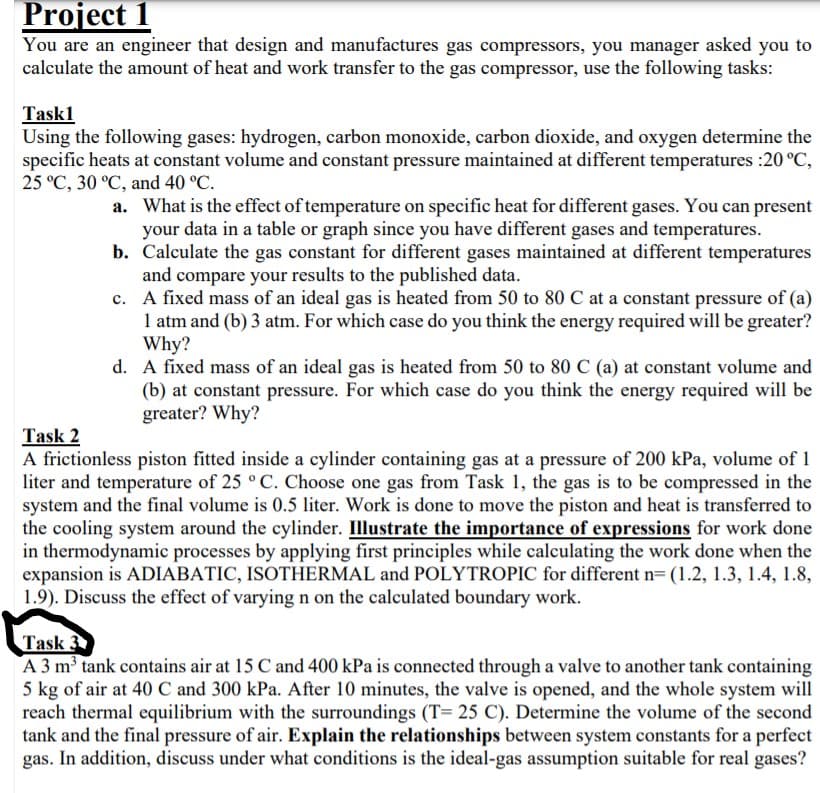Task 3 A 3 m tank contains air at 15 C and 400 kPa is connected through a valve to another tank containing 5 kg of air at 40 C and 300 kPa. After 10 minutes, the valve is opened, and the whole system will reach thermal equilibrium with the surroundings (T= 25 C). Determine the volume of the second tank and the final pressure of air. Explain the relationships between system constants for a perfect gas. In addition, discuss under what conditions is the ideal-gas assumption suitable for real gases?
Task 3 A 3 m tank contains air at 15 C and 400 kPa is connected through a valve to another tank containing 5 kg of air at 40 C and 300 kPa. After 10 minutes, the valve is opened, and the whole system will reach thermal equilibrium with the surroundings (T= 25 C). Determine the volume of the second tank and the final pressure of air. Explain the relationships between system constants for a perfect gas. In addition, discuss under what conditions is the ideal-gas assumption suitable for real gases?
Elements Of Electromagnetics
7th Edition
ISBN:9780190698614
Author:Sadiku, Matthew N. O.
Publisher:Sadiku, Matthew N. O.
ChapterMA: Math Assessment
Section: Chapter Questions
Problem 1.1MA
Related questions
Question
Task3

Transcribed Image Text:Project 1
You are an engineer that design and manufactures gas compressors, you manager asked you to
calculate the amount of heat and work transfer to the gas compressor, use the following tasks:
Task1
Using the following gases: hydrogen, carbon monoxide, carbon dioxide, and oxygen determine the
specific heats at constant volume and constant pressure maintained at different temperatures :20 °C,
25 °C, 30 °C, and 40 °C.
a. What is the effect of temperature on specific heat for different gases. You can present
your data in a table or graph since you have different gases and temperatures.
b. Calculate the gas constant for different gases maintained at different temperatures
and compare your results to the published data.
c. A fixed mass of an ideal gas is heated from 50 to 80 C at a constant pressure of (a)
1 atm and (b) 3 atm. For which case do you think the energy required will be greater?
Why?
d. A fixed mass of an ideal gas is heated from 50 to 80 C (a) at constant volume and
(b) at constant pressure. For which case do you think the energy required will be
greater? Why?
Task 2
A frictionless piston fitted inside a cylinder containing gas at a pressure of 200 kPa, volume of 1
liter and temperature of 25 ° C. Choose one gas from Task 1, the gas is to be compressed in the
system and the final volume is 0.5 liter. Work is done to move the piston and heat is transferred to
the cooling system around the cylinder. Illustrate the importance of expressions for work done
in thermodynamic processes by applying first principles while calculating the work done when the
expansion is ADIABATIC, ISOTHERMAL and POLYTROPIC for different n= (1.2, 1.3, 1.4, 1.8,
1.9). Discuss the effect of varying n on the calculated boundary work.
Task 3
A 3 m3 tank contains air at 15 C and 400 kPa is connected through a valve to another tank containing
5 kg of air at 40 C and 300 kPa. After 10 minutes, the valve is opened, and the whole system will
reach thermal equilibrium with the surroundings (T= 25 C). Determine the volume of the second
tank and the final pressure of air. Explain the relationships between system constants for a perfect
gas. In addition, discuss under what conditions is the ideal-gas assumption suitable for real gases?
Expert Solution
This question has been solved!
Explore an expertly crafted, step-by-step solution for a thorough understanding of key concepts.
This is a popular solution!
Trending now
This is a popular solution!
Step by step
Solved in 3 steps

Knowledge Booster
Learn more about
Need a deep-dive on the concept behind this application? Look no further. Learn more about this topic, mechanical-engineering and related others by exploring similar questions and additional content below.Recommended textbooks for you

Elements Of Electromagnetics
Mechanical Engineering
ISBN:
9780190698614
Author:
Sadiku, Matthew N. O.
Publisher:
Oxford University Press

Mechanics of Materials (10th Edition)
Mechanical Engineering
ISBN:
9780134319650
Author:
Russell C. Hibbeler
Publisher:
PEARSON

Thermodynamics: An Engineering Approach
Mechanical Engineering
ISBN:
9781259822674
Author:
Yunus A. Cengel Dr., Michael A. Boles
Publisher:
McGraw-Hill Education

Elements Of Electromagnetics
Mechanical Engineering
ISBN:
9780190698614
Author:
Sadiku, Matthew N. O.
Publisher:
Oxford University Press

Mechanics of Materials (10th Edition)
Mechanical Engineering
ISBN:
9780134319650
Author:
Russell C. Hibbeler
Publisher:
PEARSON

Thermodynamics: An Engineering Approach
Mechanical Engineering
ISBN:
9781259822674
Author:
Yunus A. Cengel Dr., Michael A. Boles
Publisher:
McGraw-Hill Education

Control Systems Engineering
Mechanical Engineering
ISBN:
9781118170519
Author:
Norman S. Nise
Publisher:
WILEY

Mechanics of Materials (MindTap Course List)
Mechanical Engineering
ISBN:
9781337093347
Author:
Barry J. Goodno, James M. Gere
Publisher:
Cengage Learning

Engineering Mechanics: Statics
Mechanical Engineering
ISBN:
9781118807330
Author:
James L. Meriam, L. G. Kraige, J. N. Bolton
Publisher:
WILEY